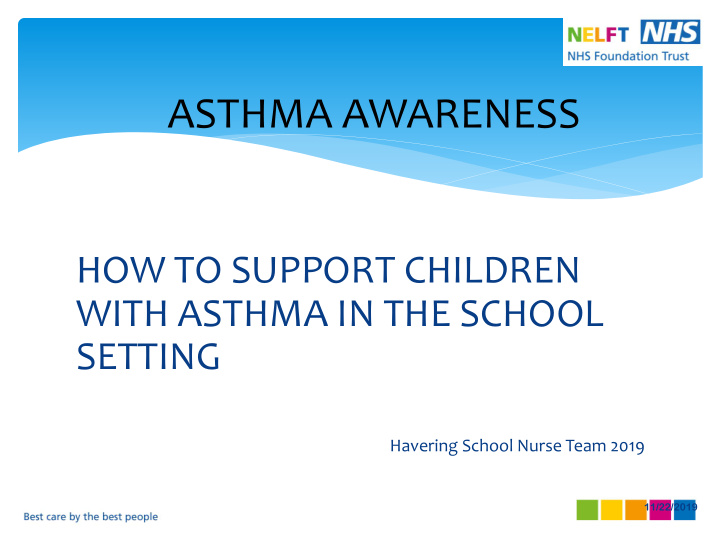



ASTHMA AWARENESS HOW TO SUPPORT CHILDREN WITH ASTHMA IN THE SCHOOL SETTING Havering School Nurse Team 2019 11/22/2019
What Is Asthma? Asthma is the most common long term medical condition in children. It is a long-term inflammatory condition that affects the airway. The usual symptoms include wheeze, difficulty in breathing, chest tightness and coughing, particularly at night or in the early morning. It varies in severity from mild, moderate to severe and can cause physical and psychological distress affecting quality of life. NHS (London asthma standards for children and young people 2016)
Asthma Facts Estimated to be 5.4 million people in the UK with Asthma (1.1 million are children) 1,200 people die each year from Asthma (20-40 will be children) 90% of deaths are possibly preventable and are attributed to delaying treatment and not seeking help quickly enough A study of 155 deaths from asthma found that 90 (58%) were classed as having mild-moderate asthma Education for health 2018
How To Recognise An Asthma Attack Persistent cough (when at rest) A wheezing sound coming from the chest (when at rest) Difficulty breathing (the child could be breathing fast and with effort, using secondary muscles in the upper body) Nasal flaring Unable to talk or complete sentences. Some children will go very quiet May try to tell you that their chest “feels tight” (younger children may express this as tummy ache) DOH 2015 11/22/2019
Information You Need To Know About A Child With Asthma What are their triggers What symptoms might they display The severity of their asthma Type of inhaler and spacer they use Where to access the inhaler and spacers at all times Do they need assistance with taking their inhaler or are they able to take independently ? Education for health 2018
What To Do In The Event Of An Asthma Attack Keep calm and reassure the child Encourage the child to sit up and slightly forward Use the child’s inhaler – if not available, use the emergency inhaler (if consent is in place) Remain with the child while the inhaler and spacer are brought to them Immediately help the child to take 2 separate puffs of their salbutamol inhaler via the spacer If there is no immediate improvement, continue to give 2 puffs at a time every 2-5 minutes, up to a maximum of 10 puff Cont ………
What To Do In The Event Of An Asthma Attack ….Continued Stay calm and reassure the child. Stay with the child until they feel better. The child can return to school activities when they feel better but contact parent to advise of the asthma attack if more than 2 puffs have been required to settle the symptoms. If the child does not feel better after 10 puffs or you are worried at ANYTIME before you have reached 10 puffs, CALL 999 FOR AN AMBULANCE. If an ambulance does not arrive in 10 minutes give another 10 puffs in the same way as before DOH 2015
Schools Responsibilities Register of all children with Asthma in school Management plan for each child Named individual responsible for Asthma in school Policy for use of inhalers and care of the child with Asthma Policy for Emergency Inhalers use in school Ability to identify children that are missing school or those that are not able to do physical activities due to poorly controlled Asthma. NHS(London Asthma Standards For Children And Young People 2016)
Asthma Plan
Emergency Asthma Policy Asthma Emergency Policy for the school which may be crossed referenced with the schools policy for supporting pupils with medical conditions. Arrangements for supply, storage, care and disposal of the inhalers. Supplies to include Salbutamol metered dose inhalers and at least 2 plastic spacers or disposable spacers. Register of children with Asthma and evidence of those parents that have given consent for emergency inhalers to be used Methods in place to advise staff of the policy, how to recognise the symptoms of an asthma attack, how to check a child is on the register, how/where to access the inhalers, who is designated to help DOH 2015
Policies And Guidance Documents DOH- Guidance on the use of emergency salbutamol inhalers in schools (March 2015) DOH- Supporting pupils at school with medical conditions (December 2015) NHS- London asthma standards for children and young people (February 2016)
Useful Websites • Asthma.org.uk (has demonstration films on using inhalers and spacers)- www.asthma.org.uk/knowledge-bank- treatment-and-medicines-using-your-inhalers • Education for health- www.supportingchildrenshealth.org (free e- learning) • DOH – policies and guidance • NHS Healthy London Partnership- www.myhealth.london.nhs.uk/healthy-london
Recommend
More recommend